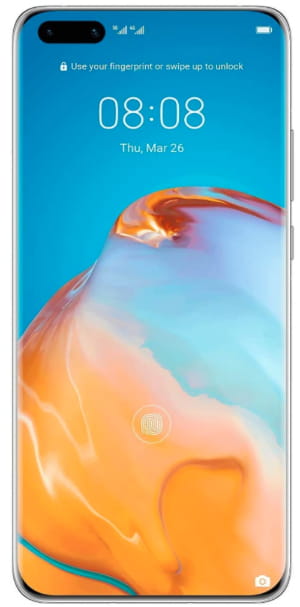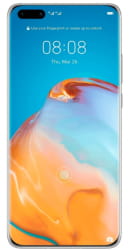Display
6.58 ''
Pixel Density
433 ppi
Relativized ⓘⓘ Pixel Density relativized to 6 inch for better comparison
475 ppi
Display Technology
AMOLED
Weight
209 g
Resolution
1080 x 2640 px
Released
2020-03
Huawei P40 Pro – again with an exceptionally good camera, 5G, an excellent design and equipment of the highest quality. Can the Huawei P40 Pro hold its own against the competition (Apple, Samsung)? Is it suitable for virtual reality?

Huawei P40 Pro – Highest hardware quality with a convincing design and equipment
Like its predecessor, the Huawei P30 Pro, the Huawei P40 Pro is convincing again with a strong all-screen design. This time, the display fills 91.6%, compared to 88.6% on the predecessor. The front consists more or less almost entirely of a display.
The display edges are rounded again, as is also the case with B. can be seen in the flagships of other manufacturers. Due to these curves, the smartphone feels very comfortable in the hand and is by no means bulky. However, it has to be a bit slippery and you should be careful not to let it fall out of your hand.
This time, 5G is standard on board and ensures extremely fast transfer rates. It is again IP68 waterproof and has an aluminum frame. In general, you can’t go wrong with this all-screen design these days, provided the quality is right. With a size of 158 x 72.6 x 9 mm, it has even shrunk by 0.4 mm compared to its predecessor.
The in-house Kirin Chipset 990 does an impressive job with 8 GB of RAM in order to play games and videos smoothly and to ensure smooth handling in general. The battery is convincing all along the line, you can actively use the smartphone for over 11 hours before the battery has to be charged. If you switch to 90 Hz, you can count on about an hour less. The cell phone can be charged to 70% in just 30 minutes.
The memory can be expanded by up to 256 GB using a memory card.
For more information, check out this video by GSMarena:
Display: 90 Hz ensures smooth operation, but as usual from Huawei – low pixel density
This time, Huawei installed a 90 Hz display, which, in contrast to conventional 60 Hz displays, is immediately noticeable when operated. Everything feels smoother and smoother and is of course fun to use this smartphone.
The colors of the 6.6 inch display are very vivid, the black is very deep and the colors look very accurate and realistic. The content is also very easy to see in the sun, although the display brightness is nowhere near the brightness of the competing products. This time there is a hole for the dual camera on the upper left edge of the display.
The fingerprint scanner is located directly in the display and always reacts very quickly and reliably.
Huawei likes to equip its smartphones with somewhat “blurred” displays. With its 1080p AMOLED display pixel density of only (!) 441 ppi, the content is relatively clear to read, but unfortunately this is a bit too little for a VR experience. In comparison: The Galaxy S20 + has 525 ppi, Galaxy S10 + 550 ppi, and the Galaxy S9 + 529 ppi (1440p). At least the battery lasts a bit longer thanks to the poor display.
Huawei P40 Pro – the Sound
The Huawei P40 Pro only uses a mono speaker on the underside of the smartphone. It can get very loud, but it cannot keep up with the competition. In addition, it just sounds extremely strange when you watch a video in Quee format and the sound only comes from one side. Huawei could think about something here and should upgrade to stereo.
Unfortunately there is no speaker connection, which means you have to use an adapter.
Very strong cameras
The Huawei P40 Pro was already known from its predecessor for its powerful camera equipment. This time there are again 4 lenses on the back and 2 on the front.
The main camera on the back consists of a wide-angle lens, an ultra-wide-angle, a 5x zoom, and a time-of-flight sensor. It takes extremely impressive photos in both good and bad weather. Videos can be recorded at 4k at 60 Hz.
The photos from the dual camera on the front take good photos, but they are not extremely impressive.
Problem: No Google services → No Google Play store
Since Huawei was not allowed to use American software for the P40 Pro, the Google services are unfortunately missing, which also includes the Google Play Store. This means that you cannot download apps like on other Android smartphones.
Install apps on Huawei P40 Pro: There are 2 variants. The first is to get the apps from the “Huawei Gallery”, which is by far missing many apps. The second option is to download the APK files and install them on your smartphone. But this option is a bit cumbersome.
Is the Huawei P40 Pro suitable for VR?
Unfortunately, like its predecessor, the Huawei P40 Pro cannot be used well for virtual reality with a low pixel density of only 441 ppi. The size of the display, the OLED technology and the performance would fit very well, but the low pixel density is very noticeable when used for VR.
The best Smartphone vor VR you can findt here: The best VR smartphones (Cardboard)
Huawei P40 Pro VR headset
There is no dedicated VR headset especially made for this smartphone, but you can choose from the best VR headsets and use your smartphone in combination with it. Here you will find the best VR headsets for smartphones: The best VR headsets
Huawei P40 Pro offers
Check out where you can get this smartphone from now:
How does work virtual reality with your smartphone?
In the video below you will see how it works. This is an example using the Destek VR headset and a Samsung smartphone. This is how it works with almost every combination of smartphone and vr headset:

